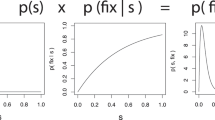Abstract
Universal grammar (UG) is a list of innate constraints that specify the set of grammars that can be learned by the child during primary language acquisition. UG of the human brain has been shaped by evolution. Evolution requires variation. Hence, we have to postulate and study variation of UG. We investigate evolutionary dynamics and language acquisition in the context of multiple UGs. We provide examples for competitive exclusion and stable coexistence of different UGs. More specific UGs admit fewer candidate grammars, and less specific UGs admit more candidate grammars. We will analyze conditions for more specific UGs to outcompete less specific UGs and vice versa. An interesting finding is that less specific UGs can resist invasion by more specific UGs if learning is more accurate. In other words, accurate learning stabilizes UGs that admit large numbers of candidate grammars.
Similar content being viewed by others
References
Ahlfors, L. V. (1979). Complex Analysis, 3rd edn, McGraw-Hill.
Aitchinson, J. (1987). Words in the Mind: An Introduction to the Mental Lexicon, Oxford: Basil Blackwell.
Andronov, A. A., E. A. Leontovich, I. I. Gordon and A. G. Maier (1971). Theory of Bifurcations of Dynamic Systems on a Plane, Jerusalem: Keter Press.
Bickerton, D. (1990). Language and Species, Chicago: University of Chicago Press.
Cangelosi, A. and D. Parisi (eds) (2001). Simulating the Evolution of Language, Springer.
Chomsky, N. (1965). Aspects of the Theory of Syntax, Cambridge, MA: MIT Press.
Chomsky, N. (1972). Language and Mind, New York: Harcourt Brace Jovanovich.
Ferrer i Cancho, R. and R. V. Solé (2001a). The small world of human language. Proc. R. Soc. Lond. B 268, 2261–2266.
Ferrer i Cancho, R. and R. V. Solé (2001b). Two regimes in the frequency of words and the origin of complex lexicons: Zipf’s law revisited. J. Quant. Linguistics 8, 165–173.
Ghazanfar, A. A. and M. D. Hauser (1999). The neuroethology of primate vocal communication: substrates for the evolution of speech. Trend. Cog. Sci. 3, 377–384.
Gibson, E. and K. Wexler (1994). Triggers. Linguistic Inquiry 25, 407–454.
Gold, E. M. (1967). Language identification in the limit. Information Control 10, 447–474.
Grassly, N., A. von Haesler and D. C. Krakauer (2000). Error, population structure and the origin of diverse sign systems. J. Theor. Biol. 206, 369–378.
Hauser, M. D. (1996). The Evolution of Communication, Cambridge, MA: Harvard University Press.
Hauser, M. D., E. L. Newport and R. N. Aslin (2001). Segmentation of the speech stream in a nonhuman primate: statistical learning in cotton-top tamarins. Cognition 78, B53–B64.
Hofbauer, J. and K. Sigmund (1998). Evolutionary Games and Population Dynamics, Cambridge University Press.
Hurford, J. R., M. Studdert-Kennedy and C. Knight (eds) (1998). Approaches to the Evolution of Language, Cambridge University Press.
Jackendoff, R. (1999). Possible stages in the evolution of the language capacity. Trend. Cog. Sci. 3, 272–279.
Kirby, S. (2001). Spontaneous evolution of linguistic structure: an iterated learning model of the emergence of regularity and irregularity. IEEE Trans. Evol. Comput. 5, 102–110.
Komarova, N. L., P. Niyogi and M. A. Nowak (2001). The evolutionary dynamics of grammar acquisition. J. Theor. Biol. 209, 43–59.
Krakauer, D. C. (2001). Kin imitation for a private sign system. J. Theor. Biol. 213, 145–157.
Lachmann, M., S. Szamado and C. T. Bergstrom (2001). Cost and conflict in animal signals and human language. Proc. Natl. Acad. Sci. USA 98, 13189–13194.
Lai, C. S. L., S. E. Fisher, J. A. Hurst, F. Vargha-Khadem and A. P. Monaco (2001). A forkhead-domain gene is mutated in a severe speech and language disorder. Nature 413, 519–523.
Lieberman, P. (1984). The Biology and Evolution of Language, Cambridge, MA: Harvard University Press.
Lightfoot, D. (1991). How to Set Parameters: Arguments from Language Change, Cambridge, MA: MIT Press.
Lightfoot, D. (1999). The Development of Language: Acquisition, Changes and Evolution, Blackwell Publishers.
May, R. M. (2001). Stability and Complexity in Model Ecosystems, Princeton, NJ: Princeton University Press.
Mitchener, W. G. (2002). Bifurcation analysis of the fully symmetric language dynamical equation. J. Math. Biol. (accepted).
Niyogi, P. (1998). The Informational Complexity of Learning, Boston: Kluwer Academic Publishers.
Niyogi, P. and R. C. Berwick (1996). A language learning model for finite parameter spaces. Cognition 61, 161–193.
Nowak, M. A. and D. C. Krakauer (1999). The evolution of language. Proc. Natl. Acad. Sci. USA 96, 8028–8033.
Nowak, M. A., N. L. Komarova and P. Niyogi (2001). Evolution of universal grammar. Science 291, 114–118.
Nowak, M. A., N. L. Komarova and P. Niyogi (2002). Computational and evolutionary aspects of language. Nature 417, 611–617.
Nowak, M. A., J. Plotkin and V. A. A. Jansen (2000). Evolution of syntactic communication. Nature 404, 495–498.
Pinker, S. (1990). The Language Instinct, New York: W. Morrow and Company.
Pinker, S. and A. Bloom (1990). Natural language and natural selection. Behav. Brain Sci. 13, 707–784.
Ramus, F., M. D. Hauser, C. Miller, D. Morris and J. Mehler (2000). Language discrimination by human newborns and by Cotton-Top tamarin monkeys. Science 288, 349–351.
Strogatz, S. H. (1994). Nonlinear Dynamics and Chaos, Reading, MA: Perseus Books.
Studdert-Kennedy, M. (2000). Evolutionary implications of the particulate principle: Imitation and the dissociation of phonetic form from semantic function, in The Evolutionary Emergence of Language: Social Function and the Origins of Linguistic Form, C. Knight, J. R. Hurford and M. Studdert-Kennedy (Eds), Cambridge: Cambridge University Press.
Uriagereka, J. (1998). Rhyme and Reason: An Introduction to Minimalist Syntax, Cambridge, MA: MIT Press.
Valiant, L. G. (1984). A theory of the learnable. Commun. ACM 27, 436–445.
Vapnik, V. (1995). The Nature of Statistical Learning Theory, New York: Springer.
Wexler, K. and P. Culicover (1980). Formal Principles of Language Acquisition, Cambridge, MA: MIT Press.
Author information
Authors and Affiliations
Rights and permissions
About this article
Cite this article
Mitchener, W.G., Nowak, M.A. Competitive exclusion and coexistence of universal grammars. Bull. Math. Biol. 65, 67–93 (2003). https://doi.org/10.1006/bulm.2002.0322
Received:
Accepted:
Issue Date:
DOI: https://doi.org/10.1006/bulm.2002.0322




